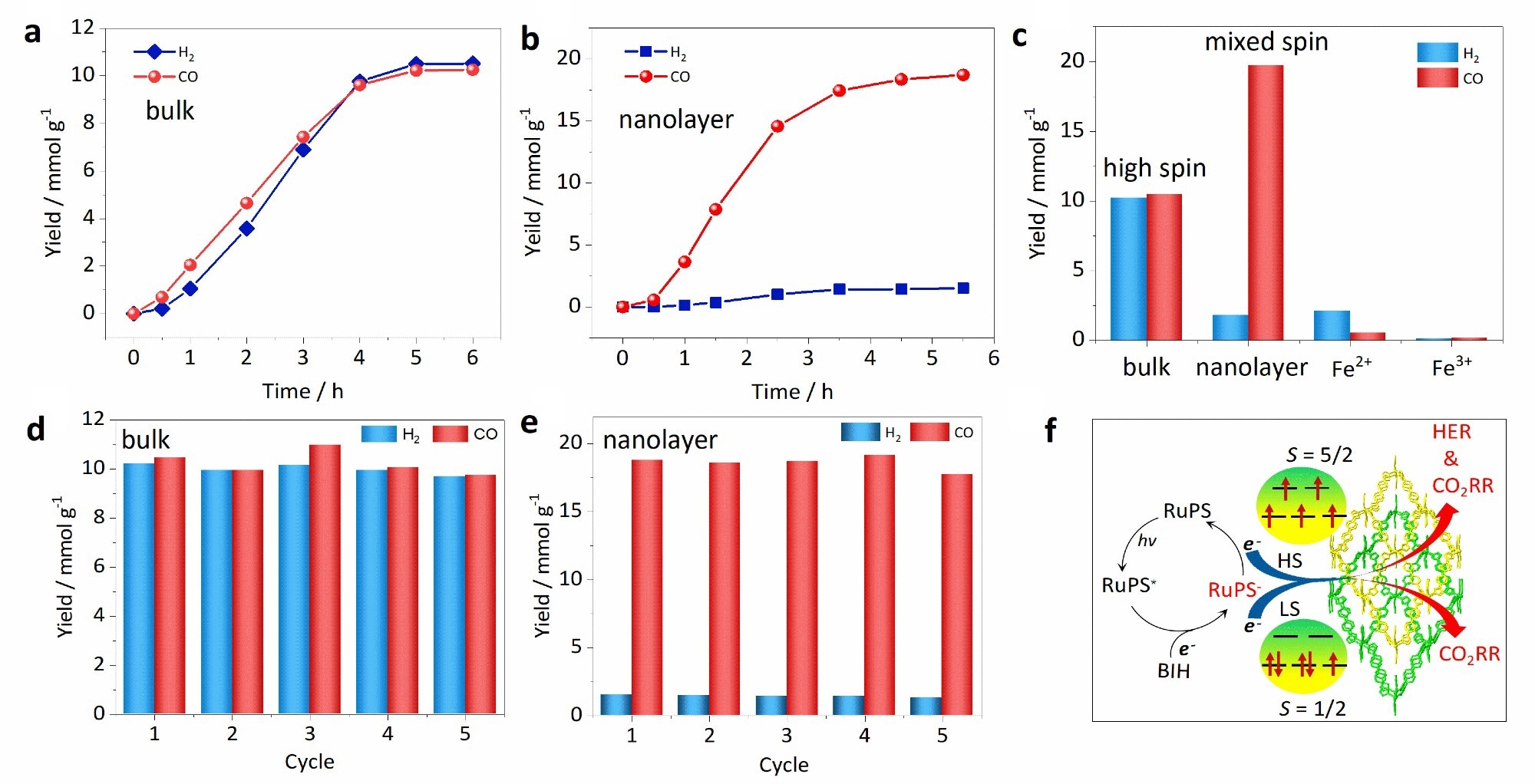Prof. WU Dayu of Changzhou University, a user of China's Steady High Magnetic Field Facility (SHMFF) of the Hefei Institutes of Physical Science of the Chinese Academy of Sciences, together with his collaborators, has proposed a simple mechanical strategy that can be used to optimize the electronic structures of the catalytic center via mechanically induced spin transition. Prof. Wu and his team have also developed a new method for designing efficient biomimetic catalysts.
 Catalytic performance. Time-dependent H2 and CO yield with (a) HS bulk and (b) MS nanolayer o-1. (c) H2 and CO yields through HS bulk o-1, MS nanolayer and control samples as catalysts after four h irradiation. Recycle experiments for H2 and CO production with (d) HS bulk o-1 and (e) MS nanolayer o-1 as catalysts. (f) The proposed photocatalytic mechanism in this work. Image credits: WU Dayu
Catalytic performance. Time-dependent H2 and CO yield with (a) HS bulk and (b) MS nanolayer o-1. (c) H2 and CO yields through HS bulk o-1, MS nanolayer and control samples as catalysts after four h irradiation. Recycle experiments for H2 and CO production with (d) HS bulk o-1 and (e) MS nanolayer o-1 as catalysts. (f) The proposed photocatalytic mechanism in this work. Image credits: WU Dayu
Prof. WU and his coworkers suggested a straightforward mechanical strategy to regulate the electronic structures of the catalytic center through a spin transition that is induced mechanically. The team also developed a novel approach for designing functional biomimetic catalysts.
The findings were published in the journal Angewandte Chemie International Edition.
Recently, the synthesis of transition-metal catalysts has received a great deal of attention. Yet, to enhance catalytic selectivity or catalytic activity, it is vital to accurately regulate the electronic structure of the catalytic center at the atomic level.
Prof. WU's research team induced partial spin crossover (SCO) of the iron catalytic active center in situ around the grid-like lattice to low spin (LS, S = 1/2) from high spin (HS, S = 5/2). The mixed-spin (MS) nanosheet catalyst possessed a high CO yield of 19.7 mmol g-1 and a selectivity of 91.6%, which is much higher than its high-spin counterpart. This was due to the iron center’s partial SCO.
In this research, experimental conditions of SHMFF were utilized to verify the spin transition of the catalytic active center.
Density functional theory (DFT) calculations revealed that the overlap of bonding orbitals between O-2p and Fe-3dxy/dyz was successfully increased by the electron configuration of the low-spin three-dimensional (3d) orbitals, thereby considerably promoting the selective adsorption of CO2.
The high-spin 3d orbital, however, overlapped with the O-2p orbital via the 3dz2 anti-bonding orbital, considerably weakening the bonding interaction between the catalyst and the substrate and decreasing the catalytic activity.
Moreover, DFT calculations revealed that the low-spin state served an important part in decreasing the activation barrier. The research team employed an electron paramagnetic resonance spectrometer, magnetic susceptibility, Mossbauer, and other experimental approaches to examine and define the electronic structure of catalysts after and before mechanical exfoliation.
They also quantified the physicochemical mechanism underlying spin catalysis through DFT calculation.
This research acts as the basis for the development of cheap, highly active, and eco-friendly CO2 reduction catalysts and also offers an important guarantee for solving the current energy and environmental crisis and achieving the goal of dual carbon.
Journal Reference:
Wu, D., et al. (2023). Spin Manipulation in a Metal‒Organic Layer through Mechanical Exfoliation for Highly Selective CO2 Photoreduction. Angewandte Chemie International Edition. doi.org/10.1002/anie.202301925.